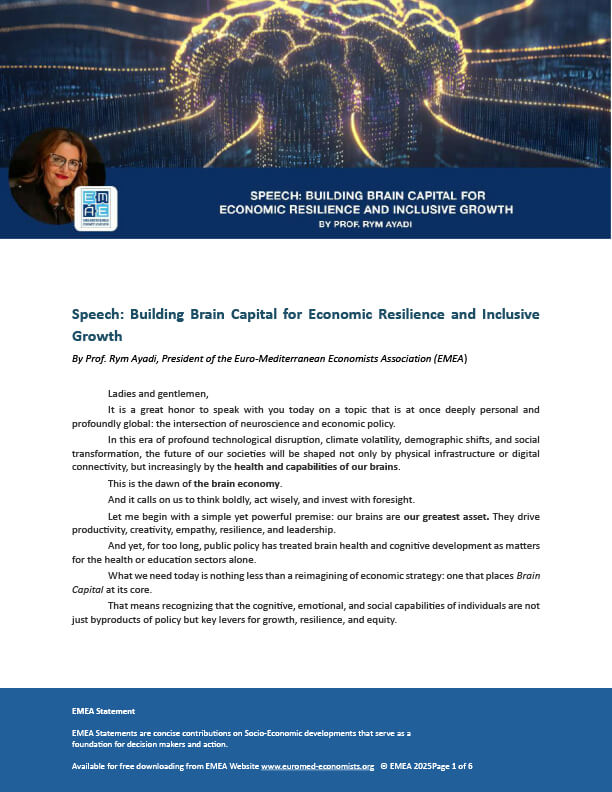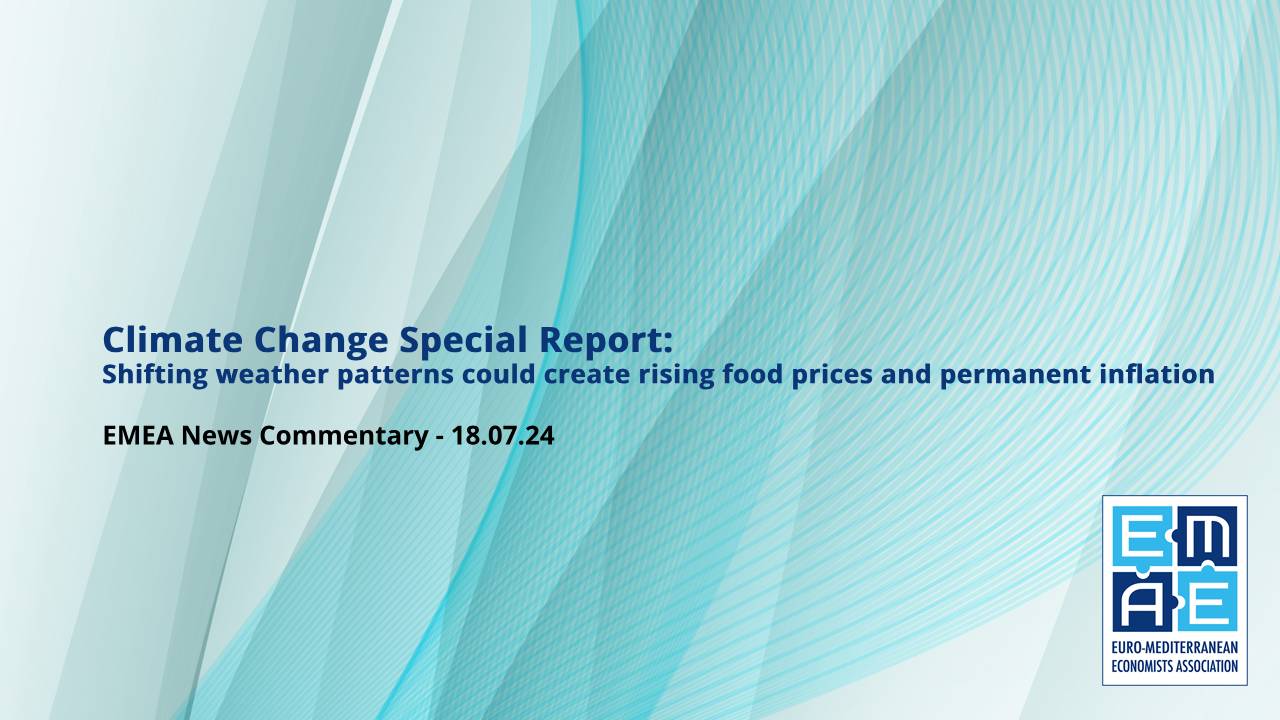Central banks are becoming increasingly concerned that climate change is causing diminishing crop yields and squeezing supplies – leading to a never-ending spiral of rising food price and inflation, a Financial Times report has warned.
The paper has interviewed a number of renowned economists about where future central bank policy may lead, focussing on various locations worldwide where fluctuating weather patterns are having a dramatic effect on food production – and prices.
On the Island of Sicily, when Giuseppe Divita’s grandparents opened their olive mill sixty years ago, the local climate was perfect for producing fruit.
The family now have groves, in addition to the mill, the FT reported. But Divita and his brother say that the combination of climbing annual temperatures and dwindling rainfall has made it increasingly difficult to turn the olives into oil.
This year, across the Mediterranean region, prices for olive oil have been at their highest for 20 years, due to reduced yields and higher input costs. Devita predicted that production problems will only worsen if the effects of climate become more acute.
The FT report recognised, however, that harvests and pricing have been disrupted by heatwaves, droughts and frosts for thousands of years. So, this isn’t a new phenomenon.
It also conceded that war and disease have played their part in recent price rises, citing the Russia/Ukraine war and swine fever, which had decimated China’s pig population.
Even so, the FT commented that “another, more sustained thread has run through many sharp increases in food prices.”
Crop yield reduction, squeezed supplies
Climate change-induced shifting weather patterns were responsible for crop yield reduction, squeezed supplies and rising food prices worldwide, it was reported. This had affected oranges in Brazil, cocoa in west Africa, olives in southern Europe and coffee in Vietnam.
Adam Davis, co-founder of the global agricultural hedge fund Farrer Capital, noted that food commodity trading prices were soaring this year, due to climate change. “Wheat is up 17 per cent, palm oil 23 per cent . . . sugar 9 per cent and pork 21 per cent,” he said.
And according to the Energy and Climate Intelligence Unit think-tank, in 2023 one third of food price increases in the UK were attributed to climate change. The lag effect of high commodity prices would continue to impact consumers, they predicted.
Frederic Neumann, chief Asia economist at HSBC, argued that whilst individual weather events could be dismissed as being isolated, “a sequence of abnormal events and disruptions” added up to climate change impact. He warned that if these were repeated, it would have “a permanent impact on the ability to supply food.”
According to a recent study by the European Central Bank (ECB) and the Potsdam Institute for Climate Impact Research, annual global food inflation rates could rise by up to 3.2% per year within the next decade or so, due to higher temperatures.
Using historic data from 121 countries between 1996 and 2021 to model future inflation scenarios, the study found that annual overall inflation would rise to 1.18% by 2035, with the global south set to be the worst affected.
Paying closer attention to rising food prices in interest rate policy
The challenge was how sustained inflationary pressure would influence monetary policy – especially given that many central banks excluded food and energy prices from their core inflation measurements because of their known volatility. Should interest rate setters now pay closer attention to rising food prices?
Neumann of HSBC predicted that more frequent interruptions to food supply would “force central banks to respond, leading to more volatile interest rates and possibly higher interest rates over time.”
Meanwhile, the UN environment programme has recently reported that the world is on track for a temperature increase of up to 2.9˚C above pre-industrial levels – double the target set at the 2015 Paris climate talks.
The FT noted that the pace of warming was accelerating beyond even the expectations of climate scientists, with last year being the hottest year on record. Further soaring temperatures are expected this summer.
In particular, this would be likely to have a major impact on agriculture, with many of the world’s most important crops predicted to be in short supply over the next decade, due to hotter weather and more frequent extreme weather events hampering harvests.
The paper cited wheat yields, which fall dramatically if spring temperatures go above 27.8˚C. In China and US, both major wheat growing regions, temperatures have frequently exceeded these levels.
Many different crops affected
Research carried out by the Friedman School of Nutrition Science and Policy at Tufts University revealed that, in the American Midwest, heatwaves are now expected every six years and every 16 years in north-eastern China. Back in 1981, such events were expected to occur only once every century.
Rice, soyabeans, corn and potatoes were said to be amongst other staples where yields could plummet. The laws of supply and demand would lead to higher food prices, said ECB economist, Friderike Kuik. In addition to extreme heat, increasingly frequent droughts, floods and storms would also have knock-on effects, she added.
It was reported that flooding in Pakistan in 2022 had decimated the country’s rice fields, whilst climate change had exacerbated the impact of the El Niño sea temperature phenomenon. This had led to low yields of sugar, coffee and cocoa.
There had also been an alteration in growing seasons caused by changing climate, it was reported. This, in turn, had created new pressures from pests and diseases.
Heavy rainfall last summer in Ghana and the Ivory Coast, where two-thirds of the world’s cocoa beans are produced, had created humid conditions that enabled black pod disease to thrive. This had rotted cocoa pods and was one of the main reasons why the global crop had fallen by over 10 per cent on the previous year.
For the farming community, climate change challenges have led to higher input costs. Land that once encouraged bumper crops through plentiful and predictable rainfall now had to be irrigated, the FT reported. More pesticides were required to keep disease and pests under control.
Back in Sicily on the Divita brothers’ olive farm, they had introduced special chilling machinery, to counter 40˚C temperatures during harvest. The hotter weather was also pushing up labour productivity costs, reflected in higher prices for consumers.
Challenging to make estimates
But William Hynes, senior climate change economist at the World Bank, said it was difficult to estimate the impact that shifting weather patterns was having on food production.
He suggested that there were many other ways in which climate change affected crop yields and food prices. “The whole system is changing,” he said, pointing out that crop yields wouldn’t suffer everywhere. Climate change would enable some regions or countries to actually grow more of certain crops. One example, amongst many, was winemaking in England.
Furthermore, other areas of the world could adapt by converting to more robust crops and alternative newly developed drought-resistant varieties.
Despite such adaptations, climate change would continue to hinder, rather than help the world’s food supplies, resulting in inflationary pressure, reckoned Paul Ekins, professor of resources and environment policy at University College London.
Even so, the FT reported that the extent of this pressure would vary. As an example, ECB researchers discovered that once rising temperatures reached a certain threshold, it triggered a sharp decline in productivity accompanied by rising inflation.
They pointed out that a temperature increase of 5˚C, from 20˚C to 25˚C, might have less impact on crop yields and inflation than one of 2˚C, from 34˚C to 36˚C, for example.
For this reason, regions such as South America and Africa – where temperatures were routinely near their crop-damaging highest – would have a more significant impact on food prices.
In contrast, more temperate Europe tended to endure the worst effects of climate change during summertime – with the resultant inflationary impact. ECB researchers found that in 2022, food inflation in Europe rose by around 0.6% due to the continent’s hot summer.
In developing countries, however, food accounted for a larger proportion of household expenditures – as much as 50% of the consumer price index. This had a magnified effect on overall inflation, said HSBC’s Neumann.
Higher food prices also meant there was less consumer spending on other items. “The food CPI itself is also much more sensitive to disruptions and swings in input prices,” he said.
Advanced economies won’t escape inflation
The FT report suggested that in a poorer and developing country, wheat could make up 70% oof the cost of bread, whereas it would be as little as 10% in a richer nation, with more significant labour, energy and transport costs.
Wealthy countries were also better integrated into global markets, so if a harvest failed, they could more easily buy from elsewhere, Neumann added. On the other hand, a poorer country wouldn’t be able to afford to source produce from elsewhere and could lack the infrastructure to import large amounts of food. “The [global] south is left holding the bag,” he continued.
But advanced economies wouldn’t escape the consequences of inflation, warned Gert Peersman, professor of economics at Ghent University, Belgium. His research suggested that over the medium term, up to 30% of the volatility in Eurozone inflation resulted from changes in international food prices, caused by unexpected global harvest shocks.
Food, whilst being a smaller portion of household expenditure in richer nations, still shaped consumer inflation expectations, Peersman and other economists have argued. This had driven actual inflation, because it pushed people to ask for higher wages.
Some economists believe that in advanced economies, inflation is amplified when there are supply disruptions by market-powerful companies. Isabella Weber, assistant professor of economics at the University of Massachusetts Amherst, said recent inflation “was triggered by shocks to essential sectors [such as food and energy] and then propagated by firms’ pricing decisions.”
Debate over central bank response
The FT reported that climate change impacts on agriculture were reigniting a debate over whether central banks should respond to food price shocks by raising interest rates.
The long-held consensus amongst economists was that they should not, because food inflation was regarded as “temporary, mean-reverting and volatile,” said Marc Pourroy, associate professor of economics at the University of Poitiers in France. “You don’t want your interest rates to be volatile,” he added.
Other economists noted that food price inflation tended to be driven by external global factors, over which small economies had no impact. Furthermore, interest rate hikes didn’t address negative supply side shocks. Indeed, they could actually be counterproductive, because they further reduced output.
Economists and other market analysts had also contended that when monetary policy orthodoxy was challenged in response to the 2008 and 2011 food price shocks, putting up interest rates hadn’t increased food supply, the FT observed. Now, however, economists took the view that climate change had altered the parameters of the debate.
Raghuram Rajan, governor of the Reserve Bank of India (RBI) from 2013 to 2016, observed that central banks in developing economies had always had to be more responsive to food prices.
“It may well be that developing countries have to take it more into account, because it’s not only a big part of the budget, it’s also a secular trend and it’s become more volatile,” he said.
The FT noted that as climate change took hold and impaired crop yields, governments would be increasingly prone to adopting protectionist policies, which could encourage further inflation.
They cited the case of India, where Prime Minister Narendra Modi had imposed export restrictions on non-basmati white rice varieties. This had seen a surge in commodity prices.
David Barmes, a Policy Fellow at the Grantham Research Institute, argued that there was justification for alternative inflation control tools, to deal with climate change. These might include price controls and targeted subsidies, but would be implemented by fiscal and industrial authorities, rather than central banks.
Tighter competition policy and antitrust measures were also required to stop influential corporations from profiteering during inflationary periods, he continued.
Precautionary measures against price fluctuations
Isabella Weber, assistant professor of economics at the University of Massachusetts Amherst, recently argued that countries ought to build buffer supplies of food commodities, as a precaution against price fluctuations. They should also levy windfall profit taxes against companies in key sectors, like food, to discourage price gouging.
Neumann acknowledged that putting up interest rates during a time of rising food prices came with risks and wasn’t always effective.
RBI former governor Rajan agreed, saying “you have to be a little careful responding to things like the temporary shoot up in price of onions.” Short-term shocks were usually quickly overcome, once fresh supplies became available, he suggested.
Nevertheless, he said food prices couldn’t just be ignored, especially as they had been high for some time. It was incumbent upon central banks to raise interest rates “not so much to kill this price increase, but to avoid everything else picking up with it,” added Rajan.
As the impact of climate change takes a firmer grip, Pourroy concluded that central banks shouldn’t overreact but admitted that food inflation will be “too important for the economy, for the people, for them to do nothing”.
https://www.ft.com/content/125e89c0-308a-492f-ae8e-6834847d1186





